By
Aswin Kumar Das
Suvendu Parida
Subha Prakash Ratha
Phani Bhusan Panda
Bishnu Prasad Gariagadu
Diptimayee Sahu
Priyanka Sahu
Anubhab Panigrahi
Chapter- 1 Introduction
1.1. General:
Mahatma Gandhi envisioned a society where the man would live in harmony with nature. He Propounded having self-sufficient village communities to achieve this goal, having a civilization built on renewable resources. He insisted for the growth of human beings from every stratum of the society and to avoid wasteful use of resources. It is in the Indian culture system to find use for everything, which may be considered as waste by many. However in the race of rapid urbanization and globalization we have lost these practices leading to unsustainable growth of cities.
As per Figure 1.1, by 2008, 30% of Indian population was living in cities generating 58% of the total GDP of India. It is estimated that by 2030, more than 40% of Indians would be living in urban areas contributing to about 70% of the GDP. The cities are going to be the engines of growth for India to become a developed nation and so, the quality of life needs to be improved for sustaining the growth in the long term. India being the second most populated country in the world has some of the most densely populated cities in the world. The rise in Indian economy in the last couple of decades has created many job opportunities in the cities leading to a rapid influx of migrants from the rural areas to the urban areas.
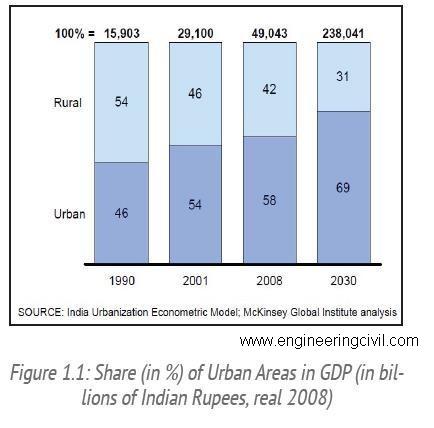
The infrastructure in the cities has not been able to keep up with the over-densification and almost all the infrastructure networks from water, waste, transport to housing have become saturated. Some of Indian cities have had the highest rates of air pollution in the world. If sufficient thought is not put into the urban design, transportation and affordability for the urbanization to follow, the quality of urban services would decline drastically by 2030, as per Figure 1.2
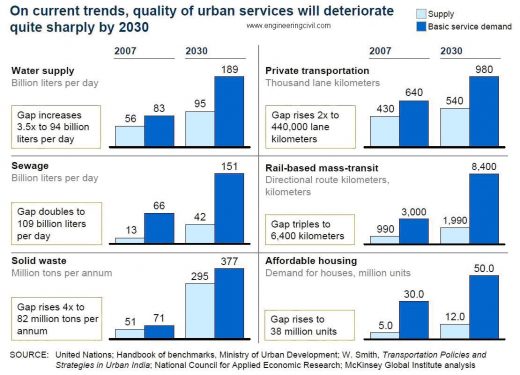
(Figure 1.2: Considerable changes in various factors over the years)
The housing stock is also projected to double in the next two decades. The housing solutions, apart from being sustainable, also need to be viable for the target groups in terms of their needs and affordability. The land cost in the cities like Mumbai is so high that majority of the people can’t afford to buy houses in Mumbai and the land cost is about 80% of the total cost of a house.
Hence, it is esseintial that India finds a sustaintable, cost effective and energy efficient house, that will help to maintain the low energy consumption as well as become a source of energy thus meeting the electricity demand while saving the environment.
Definition:
With so many different terms and so many ways to look at zero energy buildings there are inevitably many different definitions available. One of the basic definition may be as follows:
“ A net zero-energy building ( NZEB ) is a residential or commercial building with greatly reduced energy needs through efficiency gains such that the balance of energy needs can be supplied with renewable technologies.”
The building is said to be a ZEB,
If its Total energy consumption = 0; i.e.
Total energy use – Renewable energy = 0
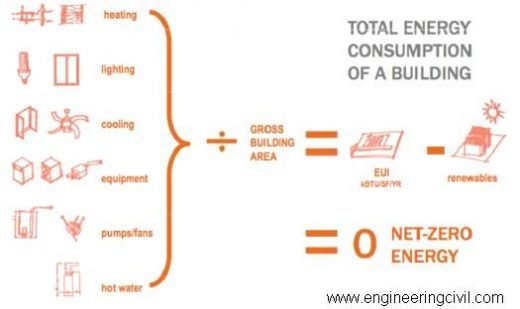
(Figure 1.3: Total Energy Consumption Equation)
1.2. ADVANTAGES AND DISADVANTAGES OF ZERO ENERGY BUILDING:
Advantages:
1. Increased comfort due to more uniform interior temperature.
2. Extra cost is minimized for new construction compared to an afterthought retrofit.
3. Reduced requirement for energy austerity.
4. More scalability and reliability of the design procurement and construction process leads to less time frame for the project. Thus, the financing cost is less.
5. The fabrication of the housing is much faster than conventional housing leading to quick project implementation and a faster move-in for the target users.
6. Use of technologies for energy, waste and water efficiency can lead to monetary benefits over life cycle of the project other than the intangible benefits.
7. Higher resale value as potential owners demand more zero net energy buildings than available supply.
8. Future legislative restriction, and carbon emission, taxes/ penalties may force expensive retrofits to inefficient buildings.
9. These are designed with so many energy efficient features, thicker walls and triple panned windows that it can create as much energy from its solar collector as the home uses over the course of a year – resulting in a zero net energy bill.
10. Using standardized building technique and energy cost modelling these buildings can be very affordable to build.
DISADVANTAGES:
1. Initial cost can be higher – effort required to understand , apply , and qualify for ZEB subsidies.
2. Very few designers or builders have the necessary skills or experience to build net zero energy buildings.
3. Challenge to recover higher initial cost on resale of building – appraisers are uniformed – their model do not consider energy.
4. Climate – specific design may limit future ability to respond to rising or falling ambient temperatures (Global Warming).
5. Without an optimized thermal envelope embodied energy and resource usage is higher than needed.
CHAPTER-2 LITERATURE REVIEW:
Kilkis, (2007) in his review on ZEB definitions indicates that in balancing the ‘zero’ both quantity and quality (exergy) of energy should be taken into consideration. Kilkis explains that “ although ZEB definition seems logical, it falls short recognize the importance of exergy in assessing the complete impact of buildings on the environment.
Total energy demand in the building is a sum of thermal and electricity demand; However, many studies focus only on one demand neglecting the other. This issue is raised by Able, (1994): “Many low-energy building projects seem to have been based on the idea ‘decrease heat supply at any cost’. In some cases, this has resulted in ‘zero-energy buildings’ which, it is true, do not need any heat supply but do, instead, indirectly need electricity, e.g., to operate the heat pump included in the system.”
Esbensen, et al. (1977) describe an experimental ZEB house in Denmark and point out: “With energy conservation arrangements, such as high-insulated constructions, heat-recovery equipments and a solar heating system, the Zero Energy House is dimensioned to be self-sufficient in space heating and hot-water supply during normal climatic conditions in Denmark. Energy supply for the electric installations in the house is taken from the municipal mains.”
Saitoh, (1984) and Saitoh, et al. (1985) in their Studies present a Natural Energy Autonomous House in Japan. According to authors: “… a Multi-purpose natural energy autonomous house will meet almost all the energy demands for space heating and cooling as well as supply of hot water for standard Japanese house in 10-15 years. For this purpose, solar energy, the natural underground coldness and sky radiation cooling are utilized.”
Gilijamse, (1995): “A zero energy house is defined here as a house in which no fossil fuels are consumed, and the annual electricity consumption equals annual electricity production. Unlike the autarkic situation, the electricity grid acts as a virtual buffer with annually balanced delivers and returns”.
Iqbal, (2003): “Zero energy home is the term used for a home that optimally combines Commercially available renewable energy technology with the state of the art energy Efficiency construction techniques. In a zero energy home no fossil fuels are consumed and its annual electricity consumption equals annual electricity production. A zero energy home may or may not be grid connected”
Lausten, (2008), “Zero Net Energy Buildings are buildings that over a year are neutral, meaning that they deliver as much energy to the supply grids as they use from the grids. Seen in these terms they do not need any fossil fuel for heating, cooling, lighting or other energy uses although they sometimes draw energy from the grid.”
Morbitzer, (2008) points out: “where possible, ZEB is built from natural, recycled or reclaimed materials. All the wood used has been approved to be sourced from sustainable resources, and construction materials were selected for their low embodied energy and were sourced within 35-mile radius of the site if possible.”
CHAPTER-3 OBJECTIVE:
1. Plan a residential building for a 1050 ft² in Bhubaneswar.
2. Check the stability of the building using STAAD-PRO.
3. Determine the dead load, live load and suitable load combination of the section.
4. Calculate the annual energy use of the building using AUTODESK REVIT ARCHITECHTURE and determine the energy use intensity (EUI).6
5. Determine the best possible orientation of the building by considering the daylight saving, climate analysis and sun path using AUTODESK ECOTECT ANALYSIS.
6. Estimate the total approximate cost of the building by using QUANTITY TAKEOFF and compare with the cost of a conventional building.
CHAPTER-4 PLANNING OF BUILDING:
4.1 : VASTU SHASTRA:
Vastu Shastra simply means the science of construction. It was a doctrine written during the Vedic era and based on the four cardinal directions and five elements of nature (Earth, Wind, Water, Air, and Soul/space). These elements are assigned to a different direction with the Soul/space in the center. Each element has a scientific role to play. It is founded on the significance of directions and each element represents a direction.
The south east corner is depicted by fire. The kitchen is in the south east corner since it is one of the first used rooms in the morning. The early sun’s rays hit this room directly providing morning light. The bedroom is to the south west. During the afternoon when the sun’s heat is at its worst, the master bedroom is unoccupied. It collects the heat and keeps the user warm during the night. The main entrance of the house is from the east side. Before entering, as per Indian tradition, the user removes his/her footwear outside the house. This signifies that the abode is as holy as a place of worship. It is even a scientifically significant practice as it keeps the house clean. Members of an Indian family spend most of their day in a common room. The north light is diffused light and is the best light for an Indian scenario. The living room, which would be the most used room, is hence placed on the north- east side. The west receives the harshest light and hence the toilets are to the west.
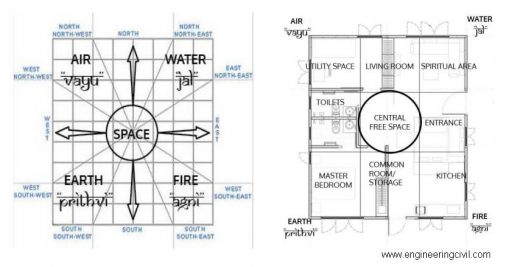
(Figure 4.1: Room Placement according to Vastu Shastra)
4.2 : PLAN:
Considering all the constraints in building by laws and vastu shastra we have proposed a plan having floor area 1038 square feet.
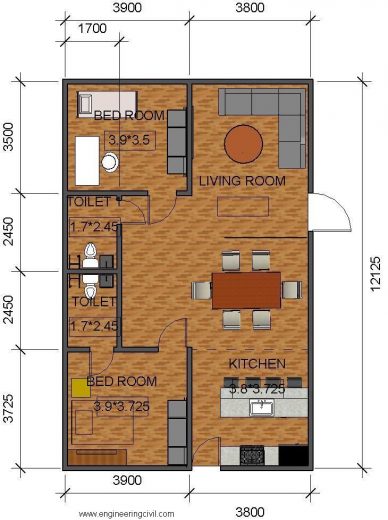
(Figure 4.2: Proposed Plan of the building)
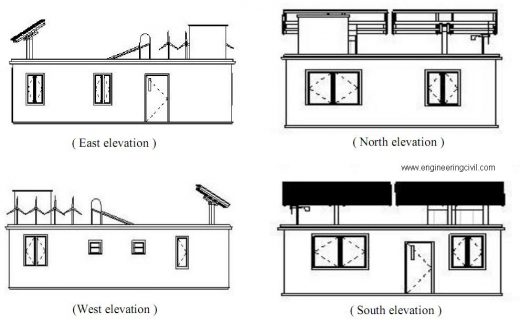
(Figure 4.3: Different elevations of building)
4.3 : PROTOTYPE
• Designed for a family of six with a basic plan, the house consists of a living area, dining and kitchen, two bedrooms and two bathrooms
• Windows are strategically placed to provide adequate light as well as cross ventilation. With larger windows on the north façade to provide diffused light and smaller ones on the west and south west.
• A continuous chajja (a projecting or overhanging eaves) was introduced on all fours sides of the house to prevent entry of the harsh direct rays of the sun into the house.
• A GI corrugated roof sandwiching puff material is used for roofing. This helps with insulation. The edges of the roof were covered using steel flashing. The rainwater drain also runs along, inside the flashing.
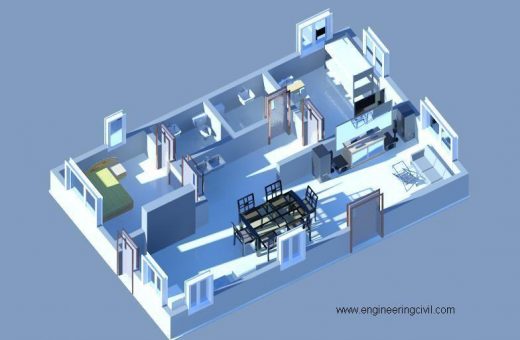
(Figure 4.4: View from the sill level)
CHAPTER- 5 MATERIAL CHART:
5.1 : Greco Tuff board Used for: Wardrobe units, kitchen, jaali
Understanding the material: Greco tuff is water proof, termite proof, fire retardant, bores free, its screw holding capacity is 5 times more than plywood whereas plywood lacks these entire features.
Loading bearing of Greco tuff is 138kg.
5.2 : Cane
Used for: Sofa set and living room furniture
Understanding the material: Caning is a method of weaving cane into furniture. It is a traditional Indian craft. The cane is then finished with dark polish.
5.3 : Carpet tiles
Used for: Flooring
Understanding the material: Carpet tiles become a good substitute for regular carpet. They are made of recycled polypropylene which is an eco- friendly material. They are 3mm thick with a size of 450mm x 450mm and are stuck using adhesive.
5.4 : PVC Bathroom tiles
Used for: Bathroom flooring and dado
Understanding the material: PVC tiles are used in the bathroom as they as flexible and easy to install. They are also 100% water proof hence ideal for bathrooms. They are 1mm thick with a size of 450mm x 450mm and are stuck using adhesive.
5.5 : UPVC Windows
Used for: Windows
Understanding the material: uPVC or un-plasticised Polyvinyl Chloride is a chemical compound of chlorine, carbon and hydrogen. It is resistant to weathering, resistant to UV rays, durable, light weight, 100% recyclable and has low thermal conductivity. It is fit with a double glazed glass.
5.6 : Ecolax
Used for: Doors
Understanding the material: The main doors are 2 hour fire rated doors. They are wooden blackboard doors with a fire core board. The internal doors have an ecolax core which is a mixture of sawmill residue and jute sticks. It is lighter than wood with excellent acoustic properties.
5.7 : Steel
Used for: Flashing and structural system
Understanding the material: Steel construction is strong and provides durability and stability. It’s useful while constructing pre fab houses as the material can be re- used without harming the environment. It is also termite resistant.
5.8 : Sintex
Used for: Roof Panels
Understanding the material: Sintex roof panels comprise of two GI sheets. One side is flat while the other side is corrugated. It has polyurethane puff in the middle which is good in thermal insulation.
5.9 : Gypsum boards and fiber cement boards
Used for: Wall section
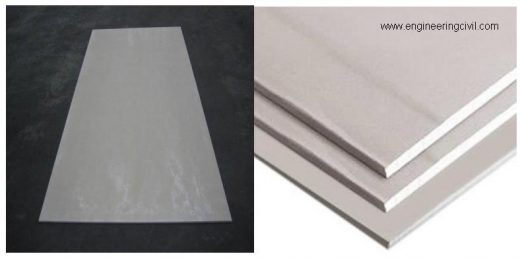
(Figure 5.1: Fibre cement Gypsum board and Fiber Cement board)
Understanding the materials: Gypsum boards have a two hour fire rating. The fiber cement boards are weather resistant. They form a sandwich panel on the steel structural system with glass wool for thermal insulation in the middle.
5.10 : V-Panels
Used for: Floor
Understanding the material: These are sandwich panels with an 8mm fiber cement boards on either side and a mixture of fly ash, cement and thermocole in the center. The total thickness is 75mm and they are joined using the tongue and groove joint.
5.11 : Other equipments: 5.11.1: Solar PV panel:
As the electricity demand of the country is rising, the existing electricity generation and distribution system in India is unable to cope up with the demand, resulting in frequent load shedding, particularly in the summer months. People in India commonly use diesel generators for making up for the load shedding, incurring a cost of around Rs. 10 per kWh. The cost of PV System is dropping very fast and the current rates are already below this Rs. 10 per kWh mark, thereby making PV generation cost effective in comparison to diesel electric generation.
5.11.2 : Wind turbine:
The wind flow near the house can be effectively utilized to produce electricity with the help of wind turbines. Now-a-days new small scale wind turbines have been designed which are almost silent and is far more efficient at converting wind in to energy. It can generate 1000kWh of energy per year at wind speeds as low as 11miles per hour. That would be enough to cover half an average household’s energy needs.
5.11.3 : Solar Hot Water:
By installing a solar hot water service,not only the family environmental impact can be lessen through reducing carbon emission but also saving money on a on going basis.It uses the solar energy and convert it into heat energy which can be used for making hot water.It contains a glass tube which can perform better when the sun is not at an optimum angle.
CHAPTER- 6 SOFTWARE SIMULATION:
6.1 : SUSTAINABILITY USING STAAD-PRO:
All the structural analysis and designing has been done using STAAD Pro. STAAD.Pro V8i is the most popular structural engineering software product for 3D model generation, analysis and multi- material design. It has an intuitive, user-friendly GUI, visualization tools, powerful analysis and design facilities and seamless integration to several other modelling and design software products. STAAD.Pro V8i supports many international design codes including Indian Standard codes.
After performing analysis using STAAD, a report was generated into MS Word file which contains all the calculations which shows that the structure is safe under loading and deflection. Also using the software it is ensured that the load transferred to the ground through footing is less than the soil bearing capacity.
After analyzing all the beams and columns, the output file is represented.
The loading condition, stress distribution, shear force diagram and bending moment diagram of Beam no-74 is shown.
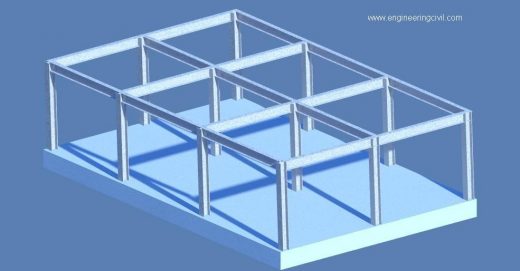
(Figure 6.1: Schematic Diagram of steel connection)
6.2 : ENERGY EFFICIENCY USING AUTODESK ECOTECH ANALYSIS:
Using Ecotect analysis following data can be found out.
6.2.1 : Climate Analysis:
The climate analysis tool determines the wind frequency, dry bulb temperature, direct solar management, average wind temperature, average relative humidity, and average rainfall of the location.
As we have selected Bhubaneswar as our project location, the above data for Bhubaneswar is found out.
Frequency of wind flow in a particular direction can be determined from the wind rose diagram.
The dry-bulb temperature (DBT) is the temperature of air measured freely exposed to the air but shielded from radiation and moisture.
The dry-bulb temperature of Bhubaneswar is shown in the graph.
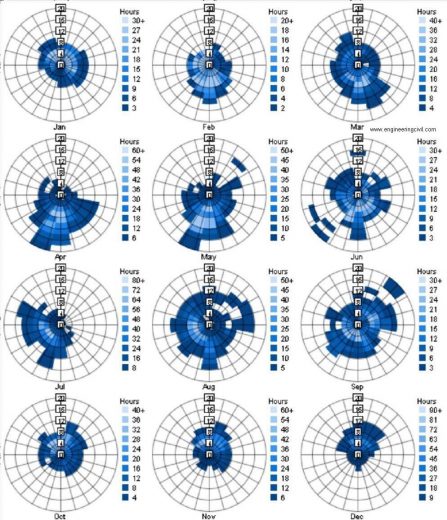
(Figure 6.2: MONTHLY PREVAILING WINDS WIND FREQUENCY (Hrs))
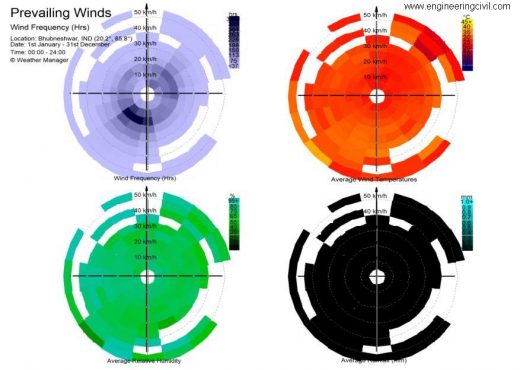
(Figure 6.3: WIND FREQUENCY, AVERAGE WIND TEMPERATURES, AVERAGE RELATIVE HUMIDITY AND AVERAGE RAINFALL)
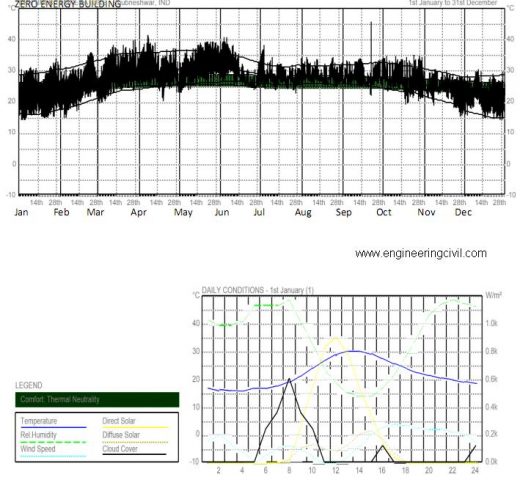
(Figure 6.4: ANNUAL DRY BULB TEMPERATURE)
6.2.2 : SOLAR PATH :
This tool enables us to know the path of sun in Bhubaneswar throughout the year and the building’s response towards it.
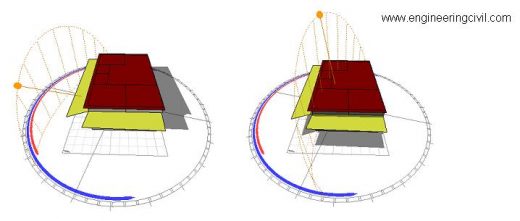
(Figure 6.5: Incident of solar ray on the building diffent times of the day )
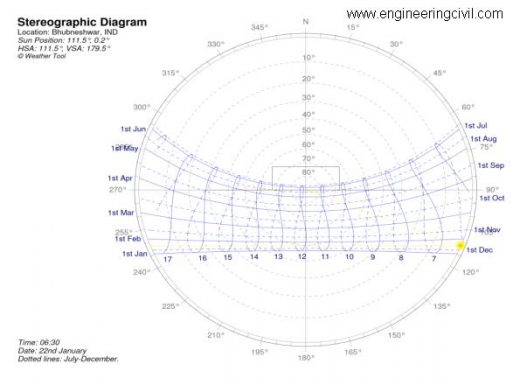
(Figure 6.6: Solar path throughout the year )
6.2.3 : Solar Exposure Analysis:
This tool helps us to determine the solar exposure of different elements of the building quantitatively.
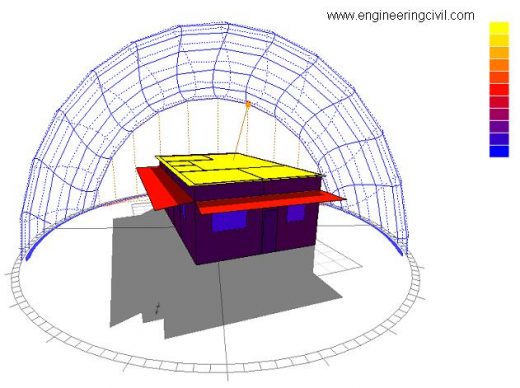
(Figure 6.7: Annual Solar Expousre)
The colour code in the figure represents the solar radiation.
While yellow represents the maximum intensity of solar radiation , blue represents the minimum.
6.2.4 : Shading Design:
The amount of sun light is more in south and west façade of the house. The harshest amount of sunlight is incident and hence minimizing the direct sunlight coming in in the summer from this facade needs to be done via appropriately sized overhang. Overhang for these windows is designed to absolutely nullify the amount of direct sunlight entering through the windows, from 9.30am to 2.30pm during a month on either side of the summer solstice, i.e. from the 21st of May to the 21st of July. We calculate the solar azimuth and elevation angle various dates and times during this period and the overhang is sized via simple geometry as shown in the figure . The yellow rays are shown for two different times of the day and the respective width of the required overhang is shown. The maximum of these widths is chosen.
The length of the south overhang required to shade the window in the desired period is calculated to be 840mm. The overhang was also sized via the ‘Shading Device Wizard’ in Ecotect and the size is found out to be 868mm, thus confirming to the value calculated geometrically. However, the boards are available in standard sizes and the closest available size of 90 mm was used.
Sh
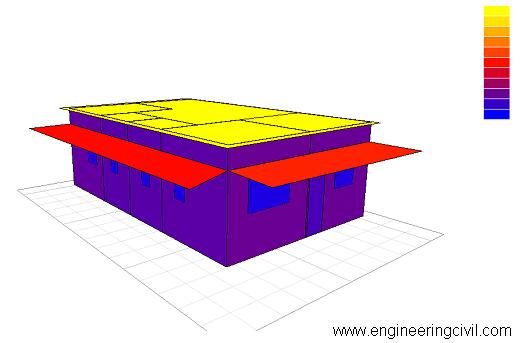
(Figure 6.9: Shading Design Wizard)
The figure clearly shows that the overhang has effectively reduce the excess solar incidence inside the building, thus, providing thermal comfort to the residents.
After analyzing the output of the above stated tools the optimum orientation of the building can be found out. In our case it is found to be 197.5 degree to the north.
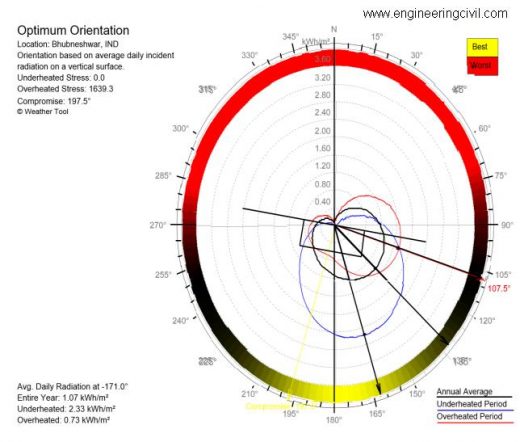
(Figure 6.10: Optimum orientation of the Building)
6.3 : AUTODESK REVIT ARCHITECTURE:
6.3.1 : Introduction
The salient features of REVIT ARCHITECURE:
• Easy to design
• User friendly interface
• Realistic 3-D view
• Integrated energy stimulation tool.
Using this software we have designed the proposed building and the output of the rendering is shown.
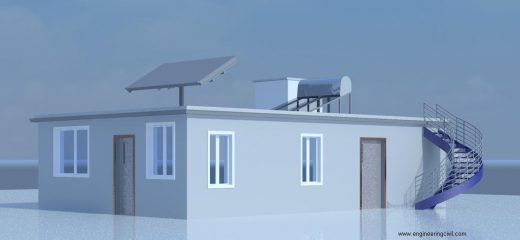
(Figure 6.11: 3D rendering view of exterior part of the building)
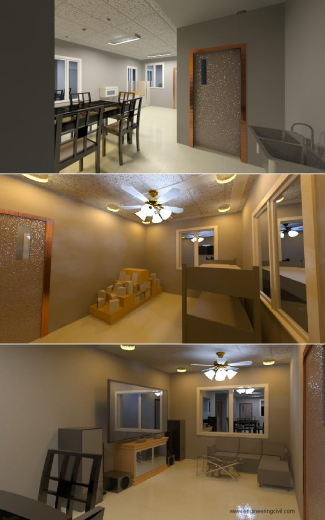
(Figure 6.12: 3D rendering view of Interior Part of the house)
6.3.2 : OUTPUT OF REVIT:
Total energy consumption of the building can be found out from Revit thus enabling us to calculate the energy use intensity of the building from which we can determine the building is a ZEB or not.
The various benefits of Revit is
• Performance Increase
• Analyze
• Adaption
• Different calculation standards
• Manual heat transfer coefficient adjustment
• Non-heated space temperature calculation
• Heating power calculations
• Cooling power calculations
• Heating demand calculations for one month, a heating season or one year
6.3.3 :CALCULATION OF THE TOTAL ENERGY CONSUMPTION OF THE BUILDING:
For a zero energy building the total energy consumption is nearly equal to zero.
6.3.3.1 : CALCULATION OF ENERGY USE INTENSITY:
From the output of REVIT, we have
The electric consumption of the building = 14227 KWh/yr. Total fuel consumption = 146 Therm
Converting this value into KWh/yr. = 146 × 29.3 = 4277.8 KWh/yr.
So the total energy being used in the building = 14227 + 4277.8 = 18504.8 KWh/yr.
As the EUI value is expressed in KBtu/gsf (Btu = British thermal unit, gsf = Gross square feet area)
Converting 18504.8 KWh/yr. into KBtu, we get 63138.37 KBtu. (1 KWh/yr. = 3.412 KBtu)
The EUI = 63138.37 KBtu/1038gsf = 60.82 KBtu/gsf
6.3.3.2 : CALCULATION OF RENEWABLE ENERGY INTENSITY:
The total renewable energy can be found out from the output of solar panel and the wind turbine from the report.
Output of solar panels of medium efficiency = 14305 KWh/yr.
A single 1 KW rated wind turbine produces 875 KWh energy per year.
As we have used 4 roof top wind turbines, the total output = 4 × 875 = 3500 KWh/yr.
So the total renewable energy consumption = 14305+3500 = 17805 KWh/yr which is equal to 60750.66 KBtu.
The renewable energy intensity = 60750.66 KBtu/1038gsf = 58.53 KBtu/ gsf
6.3.3.3 : TOTAL ENERGY CONSUMPTION:
Total energy consumption,
EUI – Renewable Energy Intensity
= 60.82 – 58.53 KBtu/ gsf
= 2.29 KBtu/ gsf
This value is nearly equals to zero. So the building is said to be approaching zero energy condition. This value can be reduced further by adopting different energy saving strategies and innovative technologies.
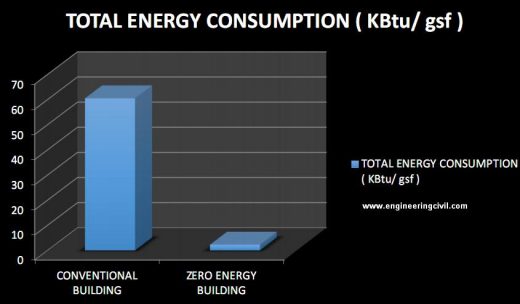
(Figure 6.13: Graph showing comparison of total energy consumption)
CHAPTER- 7 COST FACTOR:
7.1. Introduction:
Cost is one of the most important factor that should be taken in to consideration during every construction process. We have estimated the cost of our building using the software QUANTITY TAKE OFF and compared with that of a conventional building.
The Quantity Take Off software conveniently imports the REVIT file and calculate the units of each element of the building, from which we can easily calculate the cost of whole building. To make the comparison easy and comprehensive we have considered all the furniture and interior equipment including the Solar Panel, Wind Turbine, the domestic hot water system etc.
As the foundation in both the building are same we have excluded the cost of foundation from the estimation for comparison.
For easy understanding we have considered same floor area of both the buildings i.e. 1038 square feet. Both the buildings are 2BHK single stored residential units suitable for an average Indian Family of five people.
The approximate cost of both the building gives us a brief idea about the affordability at the structure and the energy efficient strategies that should be adapted to compensate the cost difference.
7.2. APPROXIMATE COST OF A NORMAL BUILDING AND ZEB (EXCLUDING THE FOUNDATION WORK)
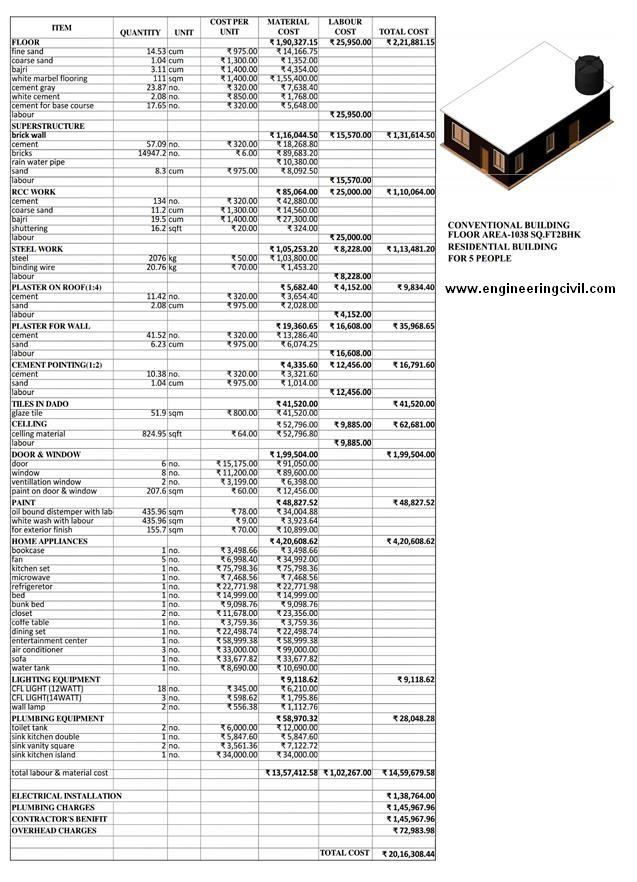
From the above analysis it is cleared that Zero Energy Building is approximately 30 % higher than normal building.
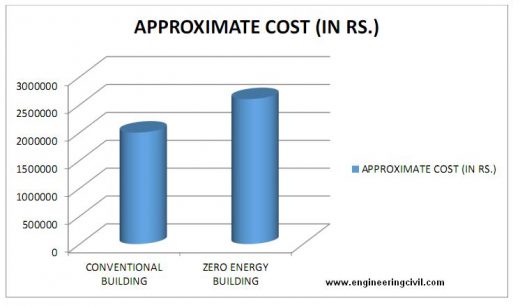
(Figure 7.1: Graph showing comparison of total estimated cost)
The total energy output from the renewable sources which amounts approximately 72449 INR. This amount compensate the total combined cost of energy consumption which is about 92524 INR and the excess cost of the building which is nearly five lakh rupees in 18-19 years.
This helps the Zero Energy Building to be cost effective after the payback period and even for the long run.
Despite being a costly technique, not only it protects the environment but also saves the most valuable energies. Thus making it worthy of the investment.
CHAPTER-8 BEING ENERGY EFFICIENT
8.1 : Glazing and Passive cooling Strategies:
The windows were sized as per the four facades along the cardinal directions, depending on the amount of solar incident on each. Minimum glazing was included on the west façade to reduce direct evening sunlight. The glazing on the north façade was maximized to bring in diffused natural light. High performance coated double glazed glass with a low SHGC (Solar Heat Gain Coefficient) was selected to reduce heat gains during the day and to reduce heat losses during the night as glazing was found out to be the major source of heat loss. This significantly reduced the HVAC (heating, ventilation and air conditioning) loads, as much as 28%.
8.2 : Waste Infrastructure
In a truly sustainable society, there is nothing known as waste. Everything is a resource. The waste segregation at the household level can go a long way in enabling the development and efficient utilization of waste as a bio-gas fuel. The waste has to be segregated into 2 categories – kitchen waste and other wastes (plastics, paper etc.). The kitchen waste can be used to fuel a biogas digester. The biogas digester can be used to make biogas, which can be used for cooking or fed into the “community kitchen”
The total domestic waste from the township would be approximately 7 tons/day. From 1 ton of food waste, the digester produces biogas having 40 m3 of methane, which is equivalent to 2 domestic LPG cylinders, used for cooking in urban areas. This means that if all the organic waste of the city is used for biogas generation, then it would lead to 2×7 = 14 LPG cylinders equivalent of biogas generation/ day, which are 5000 LPG cylinders per year. That means, about 20% of the cooking needs of the society can be fulfilled with biogas generation from the domestic waste. This would generate organic manure as a by- product which would be organic manure for the plants, apart from converting methane to carbon di-oxide, thereby reducing the emissions. The space required for setting up a 1 ton biogas plant is 150 sq. m. These could be set up in the open spaces in different residential areas and near the eateries
8.3 : Water Infrastructure:
It is said that the coming wars in the Indian sub-continent would be water wars and so, it is important to conserve water and be self-sufficient in it. The average domestic water consumption is 135 litres per capita per day. Adding the water demand for other land uses, the total water demand for the township comes to 200 litres per capita per day. After some treatment let 50% of the water is useful for meeting the water demand.
if the water can be stored or used to recharge the ground water through rain water harvesting so that it can be used in other parts of the year. The township can be made self-sufficient for water needs if care is taken for proper storage of the rain water.
8.4 : Wind Passing:
The wind data of the locality suggests that it predominantly flows from the west, north-west and north directions. Wind enters the house from the big windows are provided on the north facade and the windows on the west façade as well. The air heats up in the house, rises up and is pushed out through the open-able clerestory windows located all along the east façade and also the windows on the south. This causes a wind flow throughout the house from a north-west to the south-east directions.
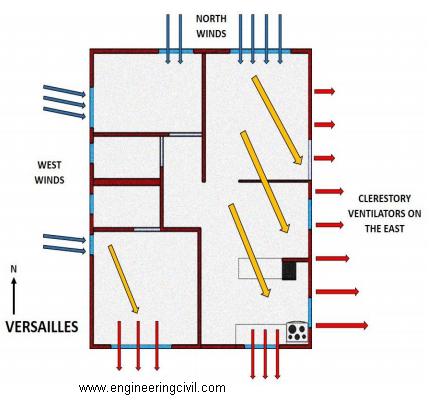
(Figure 8.1: Effective Wind Circulation strategy)
8.5 : Acoustic Design:
This is one of those aspects of design, which is paid least attention, unlike functionality and aesthetics. Unacceptable levels of noise can lead to losing of focus and cause irritation. As the neighborhoods become denser, the problem would become more acute, unless designed properly. Thus, it is important to understand the outside sound levels, sounds produced by the equipment inside the house and select the right materials and equipment, which can insulate and absorb these sounds such that acoustic comfort is realized inside the house.
8.6 : Sound Insulation From Outside:
The acoustic properties of building materials i.e. walls, glass and doors were found by testing in the labs to obtain the necessary parameters. The thickness of the layers of the external wall, windows and doors are given in the Table below.
| Building Component | Layer Material | Thickness (mm) |
|
External Wall |
Fibre-Cement Board | 12 |
| Gypsum Board | 15 | |
| Glasswool Insulation | 90 | |
| window | Glass | 12 |
| Air gap | 12 | |
| Door | Fire Retardant Plywood | 50 |
8.7 : Noise Barriers:
Various types of noise barriers can be provided to prevent the house from direct effect noise pollution.Tree can also be used as a barrier to reduce noise pollution near the building.
Besides all this methods explained above to effectively reduce the energy use & store it for future application; there are numerous techniques that can be implemented to make the house energy efficient. Some of these methods includes: urban farming, creation of buffer zones, solid waste and hazardous waste management, use of traditional elements that have low energy consumption & affordability, Use of high rated electronics appliances that have low emission level etc.
CHAPTER-9 INNOVATIVE TECHNIQUES:
9.1 : PV Panel as Shading:
The PV Panels are generally fitted on the roof tops. Besides meeting the power generation demand it can also be used as a shading device by appropriately placing it.
India being close to the equator is very sunny for most of the year and people generally prefer to sit in sun shades when outdoor. This got us to think to provide a sun shade in the roof. Usually the roofs are underutilized and therefore, we plan to put a roof garden where fresh produce can be grown in the roofs as well as proper shading can be provided by the proper placement of PV panels. PV panels will be put at sufficient heights and made safe for people to sit underneath.
Usually PV panels in the roof take up the space in the terrace but we can utilize the roof space for PV sunshade with garden and recreational area. Building integrated PV panels usually are not used to their full potential but tracker based PV panels will generate maximum energy based on sun’s movement. We plan to use the PV panels not just as energy source but also a sun shade.
The PV panels mounted on the tracker will be at sufficient height and limited to +/- 30 degree tilt so that at any point of time, PV panels are not below 180cm (average height of India).
9.2 : PCM (Phase Change Material):
Phase change material (PCM) provide for high density thermal energy storage due to their high latent heat of fusion. In our house design we will be generating hot water using solar thermal collectors. Thus to provide security against variable solar insolation and to provide water at a fairly constant temperature we are planning to use phase change material in our solar tanks.
We have procured PCM are in form of 42 mm diameter encapsulated balls. These balls shall be inserted into the water tank. Whenever the temperature of the water rises above 48 °C the PCM gets charged and when the temperature falls below 45 °C the PCM gets discharged thus heating the water.
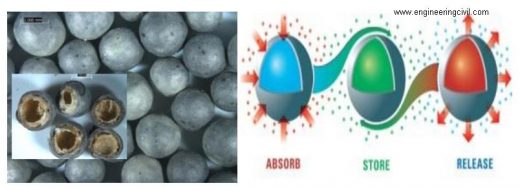
(Figure 9.1: Phase Change material)
In the absence of PCM, when the water is below required temperature a backup electric heater would be required. By having a bio-degradable PCM we are decreasing the possibility of using electricity for the heater. To quantify the energy benefits; 30kg of PCM can be used that stores energy upto 1.8kWh. This means it can save 1.8 kWh of electricity in one go that an electric heater would have consumed.
9.3 : CLOTH DRYER
The principle behind the working of the clothes dryer is two-fold.
1. Using hot dry air from the exhaust of the air-conditioner to dry the clothes
2. Using hot water to raise the temperature of the cloth and facilitate moisture removal
This two-pronged approach is extremely suitable to the context in which the design has been done. Most houses have ACs and the exhaust air is a readily available resource. Secondly, the house in which this is a part has a solar hot water system, thus even hot water generation needs no electricity. Additionally, the hot water is at an appropriate temperature (~50 deg C) for drying clothes
9.4 : SOLAR OVEN
Conventional electric ovens are usually power guzzlers with a power rating upto 3kW. When used not only do they consume a large amount of electricity but also cause power peaks on the utility which are not desirable. To tackle this, our team is fabricating an innovative solar oven.
A) Design:
The main innovative feature of the oven is the solar thermal collector. A unique design that incorporates sand as the thermal mass allows the air to reach high temperatures pretty quickly. This collector is integrated with a conventional oven. So when adequate temperatures are available a blower pumps air into the conventional oven through a duct. When the temperatures are not enough in the solar collector the conventional heater can be turned on with a flick of a switch.
B) Benefits:
Since the solar oven uses electricity only for the air blower it provides a huge benefit from electricity consumption point of view. The savings can be upto 2.5 kWh of electricity per day with an hour’s usage of the solar oven. This product is a joy for any middle class Indian household as it utilizes the abundant solar energy and does not consume significant electricity.
CHAPTER 10: IMPLEMENTATION
10.1 : INDIRA PARYAVARAN BHAVAN, DELHI
• India’s first net zero energy building
• Constructed with adoption of solar passive design and energy-efficient building materials.
• Building boasts an earthquake-resistant structure with a total plinth area of 31,488 sq. m.
• More than 50 per cent area outside the building is a soft area with plantation and grass.
• The building has a robotic parking system in the basement that can accommodate 330 cars.
• Thin-client networking system has been provided instead of conventional desktop computers to minimise energy consumption.
• Design allows for 75% of natural daylight to be utilised to reduce energy consumption.
• Installed capacity of 930 kW peak power, the building has the largest rooftop solar system among multi-storied buildings in India.
• Union environment minister Prakash Javadekar showcased the building to United Nations secretary general Ban Ki-moon on 13/1/15
• Total energy savings of about 40 per cent through the adoption of energy efficient chilled beam system of air-conditioning
• Air-conditioning is done by convection currents rather than airflow through air handling units, and chilled water is circulated right up to the diffuser points unlike the conventional systems.
• UPVC windows with hermetically sealed double glass. Calcium Silicate ceiling tiles with high recyclable content and grass paver blocks on pavements and roads, renewable bamboo jute for door-frame, flyash bricks
• Reduction in water consumption has been achieved by use of low-discharge water fixtures, recycling of waste water through sewage treatment plant, use of plants with low water demand in landscaping, use of geothermal cooling for HVAC system, rainwater harvesting and use of curing compounds during construction
Architectural design of the building is primarily based on following concepts
• Preservation of maximum possible number of trees standing over the site
• Solar Passive Architecture with proper orientation and shading of Fenestrations
• Appropriate building envelope design with envelope insulation to reduce heat intake
• Use of permanent, durable and local materials such as sand stone on exterior face, low heat transmission glass and reflective roofing
• Priority for pedestrians in the front, with vehicular access on the sides of the building
• Reduction of conventional lighting load by ensuring 75% day-light use
• Natural ventilation due to stack effect
• The building is designed in such a way that there is free ventilation across the entire building
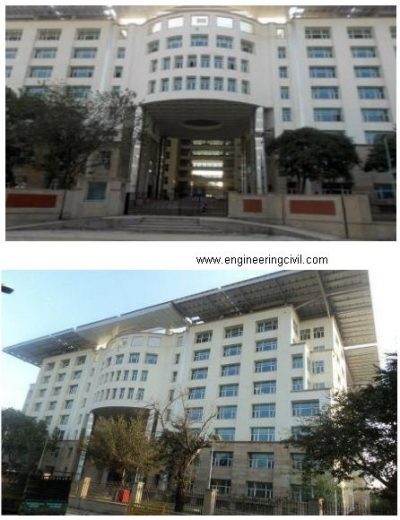
( Indira Paryavaran Bhaban, New Delhi )
The new Hyderabad Infosys campus, Faced with the need to accommodate its fast growing workforce, Infosys realized it had a chance to stage what Parikh ( Head of green innovation, Rohan Parikh, is a passionate advocate of energy efficiency – particularly for cooling, which accounts for the majority of Indian office consumption) calls “a massive, unprecedented experiment”. So it built a new block in the form of two separate wings – identical in every respect apart from their energy system. One was designed along conventional lines; the other incorporated the latest efficiency technologies, notably “radiant cooling”. This draws heat from the room to walls cooled by water circulating through embedded pipes.
Parikh and his team expected to trim energy bills, and they weren’t disappointed: the green building recorded savings of around 38%, he says, compared to its conventional twin. More striking, though, was that it cost 1% less to build. At a stroke, this whips the rug from under the feet of those who claim that energy efficiency is a capital cost too far. “There’s no question of arguing over payback times”, says Parikh, “because the payback time here is zero. It’s cheaper all around.”
10.3 : COMMON WEALTH VILLAGE, DELHI
Commonwealth Games Village Location : New Delhi Site Area : 473000 m2 Built-up Area : 156000 m2
Energy consumption reduction : 61% reduction from TERI GRIHA benchmark EPI : 78 KWh/ m2 /year
Renewable energy installed on site : 128 KW GRIHA rating : 2 Stars
The following strategies were adopted to reduce the impact of the proposed building on natural environment:
I. Sustainable Site Planning:
• Roads were regularly sprinkled with water for dust control; wheel-washing was done for vehicles at entry and exit of the site.
• Dust screens provided around construction area to prevent air pollution. • Top soil stored and preserved on adjacent site for later use.
• Utility corridors designed along roads and pathways on site.
II. Ensure health and well-being of construction workers on site:
• Sanitation/safety facilities for construction workers provided as per NBC 2005. • Clean and hygienic accommodation, toilet facilities and safe drinking water provided to all workers on site.
III. Reduction in water consumption (compared to TERI GRIHA benchmark):
• 61.1 % reduction in building water consumption by use of low-flow fixtures.0
• Waste water recycled and reused within the complex.
• Reduction in landscape water consumption by planting native species of trees and shrubs and by installing efficient irrigation systems.
IV. Reduction in energy consumption (compared to TERI GRIHA benchmark) while maintaining occupant comfort:
• ECBC compliant building envelope.
• Installed air conditioning system based on Variable Refrigerant Volume (VRV)
• Energy efficient lighting systems.
V. Renewable energy technologies installed on site:
• 31% outdoor lighting powered by solar energy.
• 10% annual energy requirement for internal artificial lighting proposed to be met by solar energy.
CHAPTER-11 CONCLUSION:
The goal of green building and sustainable architecture is to use resources more efficiently and reduce a building’s negative impact on the environment. Zero energy buildings achieve one key green-building goal of completely or very significantly reducing energy use and greenhouse gas emissions for the life of the building. Zero energy buildings may or may not be considered “green” in all areas, such as reducing waste, using recycled building materials, etc. However, zero energy, or net-zero buildings do tend to have a much lower ecological impact over the life of the building compared with other “green” buildings that require imported energy and/or fossil fuel to be habitable and meet the needs of occupants.
Because of the design challenges and sensitivity to a site that are required to efficiently meet the energy needs of a building and occupants with renewable energy (solar, wind, geothermal, etc.), designers must apply holistic design principles, and take advantage of the free naturally occurring assets available, such as passive solar orientation, natural ventilation, day lighting, thermal mass, and night time cooling.
In conclusion, we decided that for our Zero Energy House Project using solar energy was the best energy source in regards to saving energy and cost efficiency. After brainstorming and researching we came to an agreement that photovoltaic solar panels were the best solution to use in constructing our house. We wanted to keep the house on the smaller side so that the amount of energy needed to heat the house was lower than that of a bigger house.
To solve this problem the house we designed was 1050 square-feet, one story, 2BHK and would comfortably be able to accommodate two people. The installation of the solar panels initially would be costly, but in the long run the owner of the house would save money on their energy bill. More importantly, in the scarcity of natural resources we would be providing a self- sufficient, energy saving, non-polluting, Zero Energy House. The solar panels that would be installed would be on the back side of the house, which would be facing south. This would allow for the most direct sunlight to be absorbed by the panels. Also on the south side, there would be three windows that run the length of the wall, allowing the most sunlight to enter in the summer and heat the living room/kitchen area.
We combined the energy efficient qualities of our house with aesthetic beauty to produce a home that satisfies the customers’ needs. This would attract people to buy more Zero Energy Houses which would result in less pollution and less dependence on fossil fuels. As a group we believe that we were successful in providing a Zero Energy Home that is also aesthetically pleasing.
REFERENCES
• “Prime Minister Inaugurates “Indira Paryavaran Bhawan”. Bhawan is India’s First on Site Net Zero Building”. Press Information Bureau, Government of India. 25 February 2014. Retrieved 23 May 2014.
• Zero Energy Buildings: A Critical Look at the Definition” Paul Torcellini, Shanti Pless, and Michael Deru, National Renewable Energy Laboratory; Drury Crawley, U.S. Department of Energy. National Renewable Energy Laboratory report: NREL/CP-550- 39833. June, 2006
• A Common Definition for Zero Energy Buildings” US Department of Energy, September 2015.
• Net-Zero Energy Buildings: A Classification System Based on Renewable Energy Supply Options.” Shanti Pless and Paul Torcellini. National Renewable Energy Laboratory report: NREL/TP-5500-44586, June 2010
• “Net Zero Energy Solar Buildings”. International Energy Agency: Solar Heating and Cooling Programme. 2014. Retrieved 25 June 201
• World Business Council for Sustainable Development, August 2007, Energy Efficiency in Buildings: Business Realities and Opportunities Retrieved: 2007-09-05.
• “Solar Decathlon”. Wikipedia, the free encyclopedia
• Honda. “Honda Smart Home US”. Honda Smart Home US. Retrieved 2016-03-04.
• Salom, Jaume; Widen, Joakim; Candanedo, Jose A.; Sartori, Igor; Voss, Karsten; Marszal, Anna Joanna (2011): Understanding Net Zero Energy Buildings: Evaluation of Load Matching and Grid Interaction Indicators. Proceedings of Building Simulation 2011: 12th Conference of International Building Performance Simulation Association. Sydney
• www.wikipedia.org
We at engineeringcivil.com are thankful to Er Anubhab Panigrahi for submitting this very useful paper on “Concept of Zero Energy Building” to us. We are sure this would be great use to all seeking more information on Zero Energy Buildings.
If you have a query, you can ask a question here.



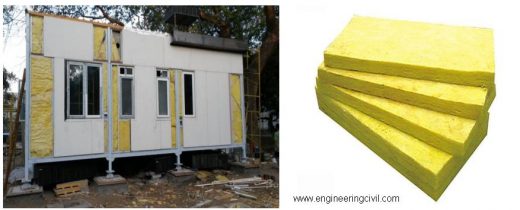
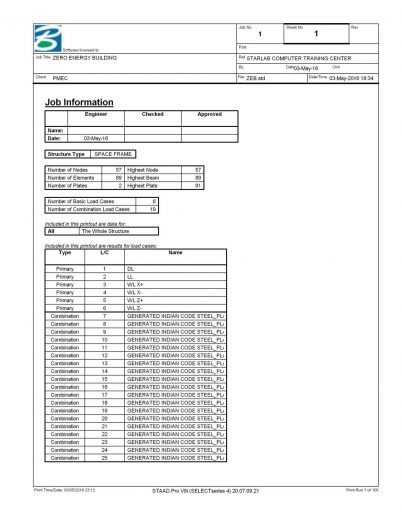
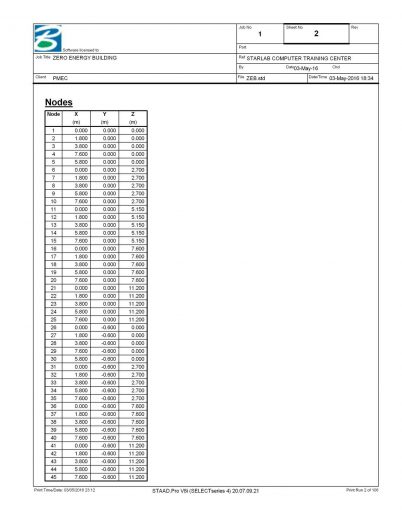
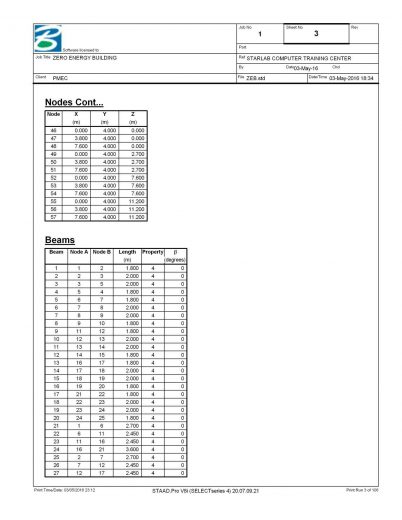
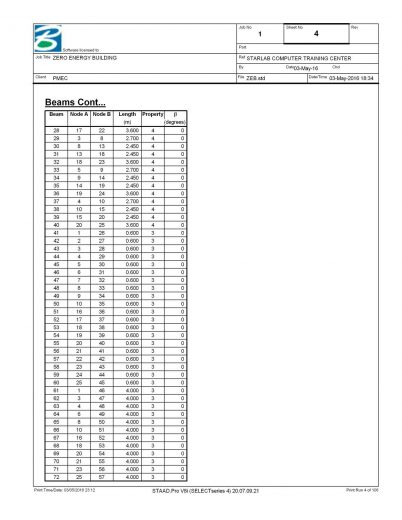
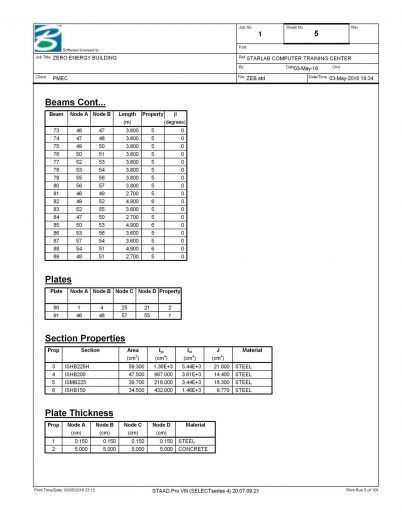
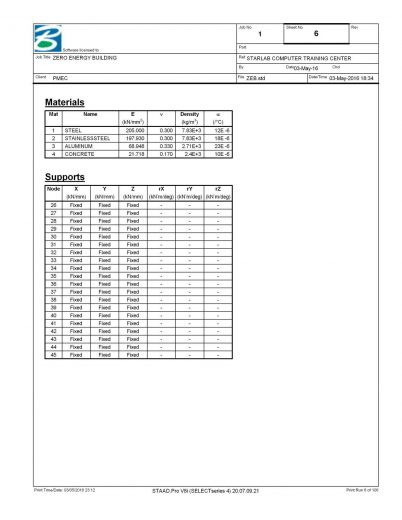
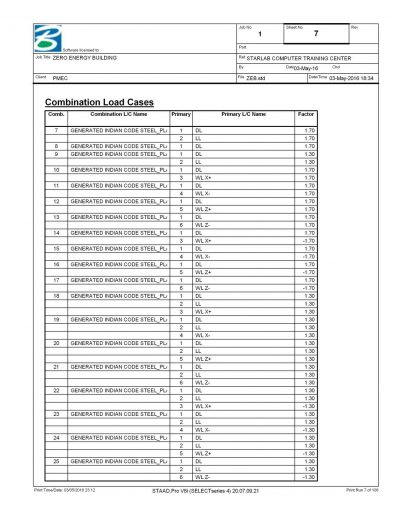
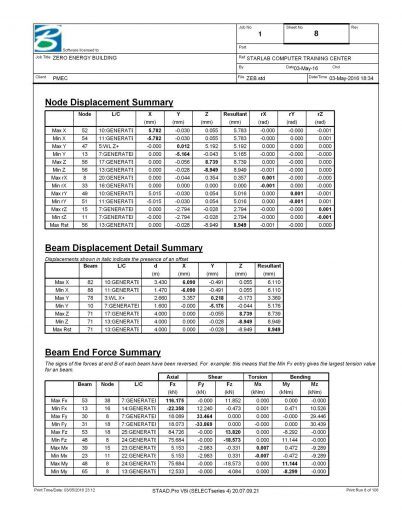
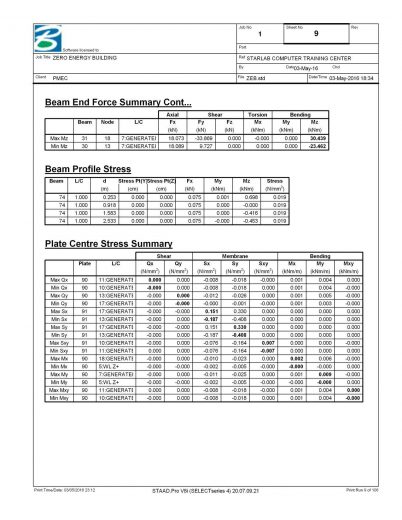
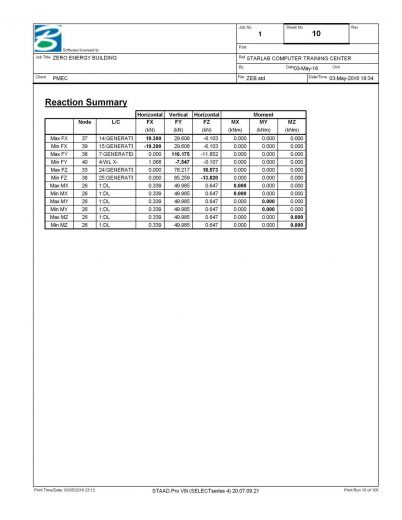
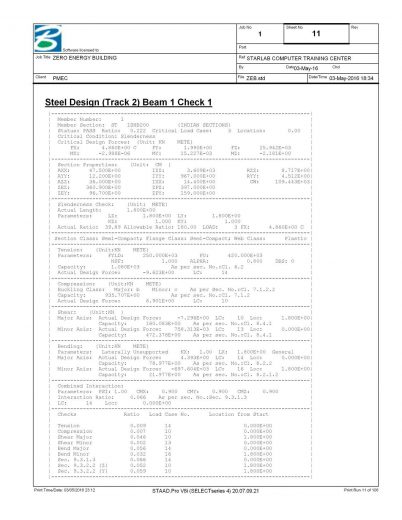
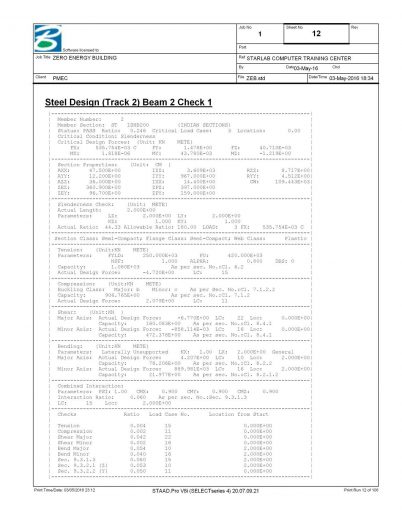
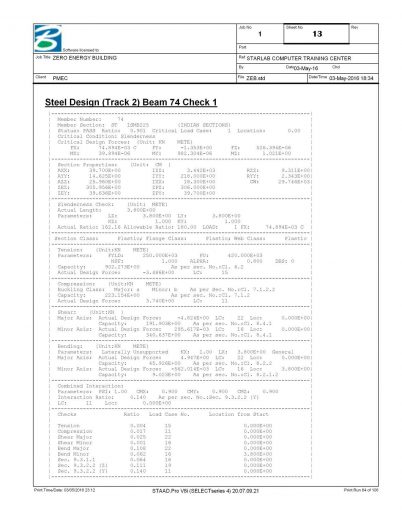
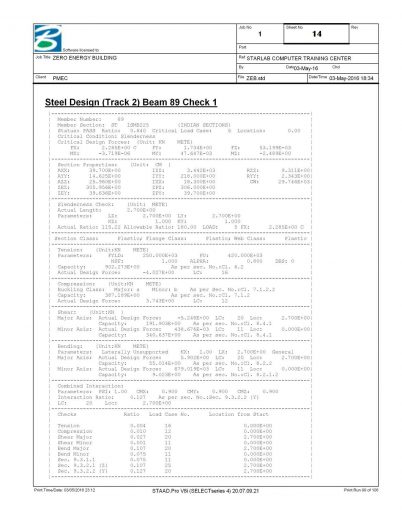

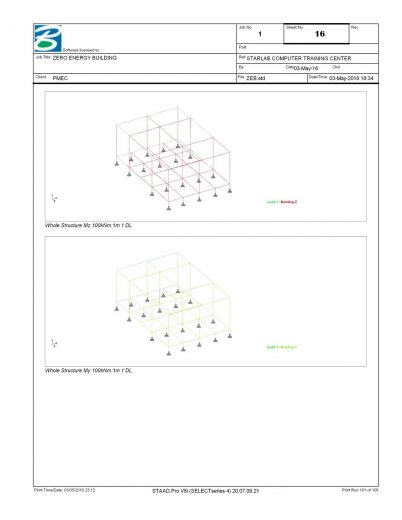
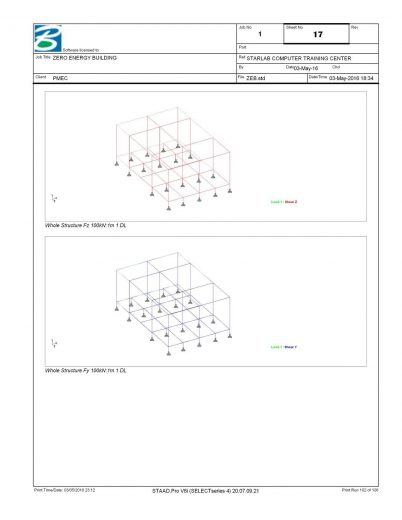
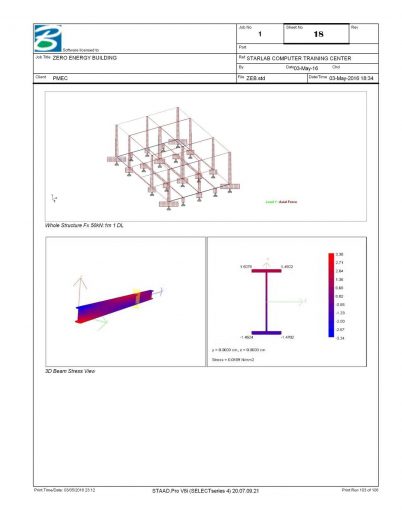
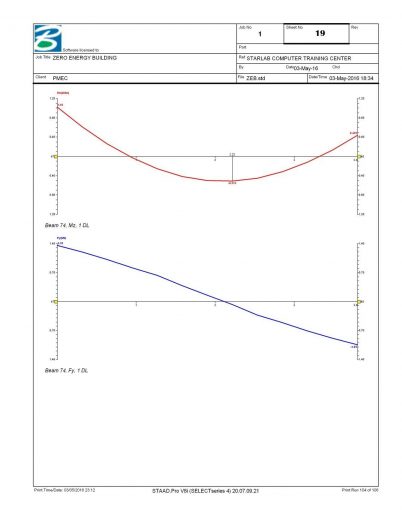
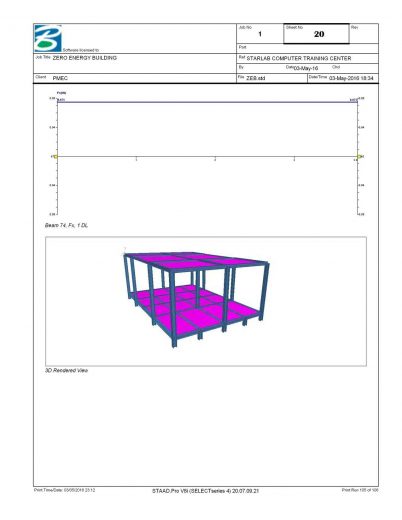
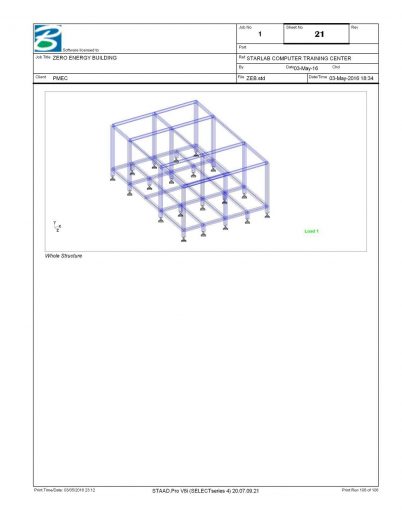
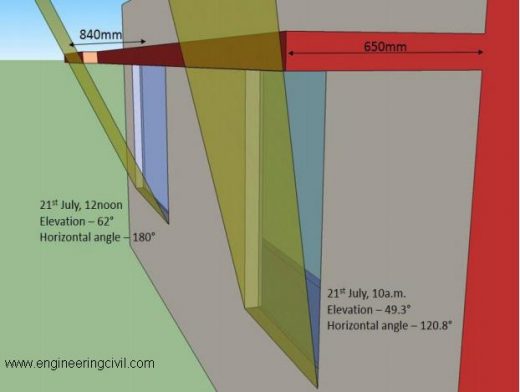
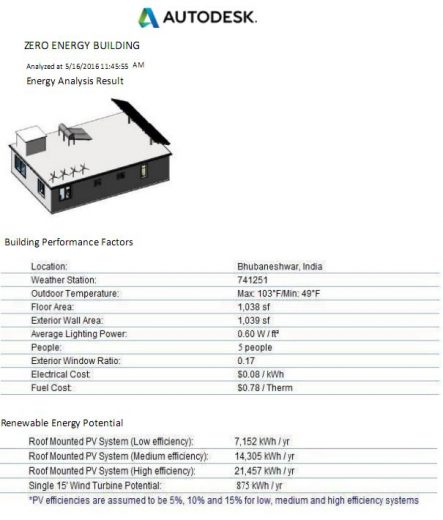
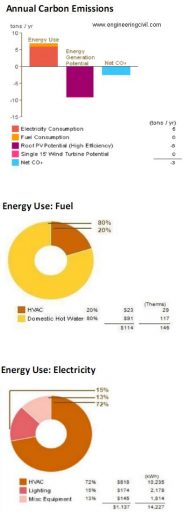
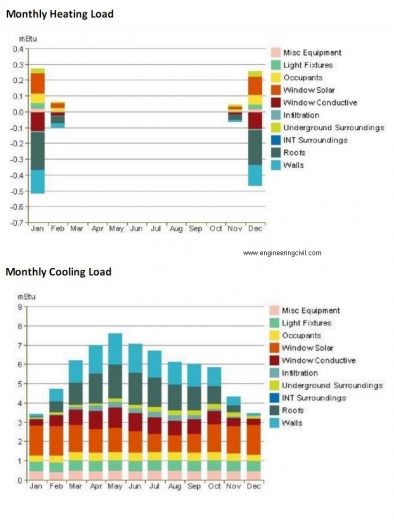
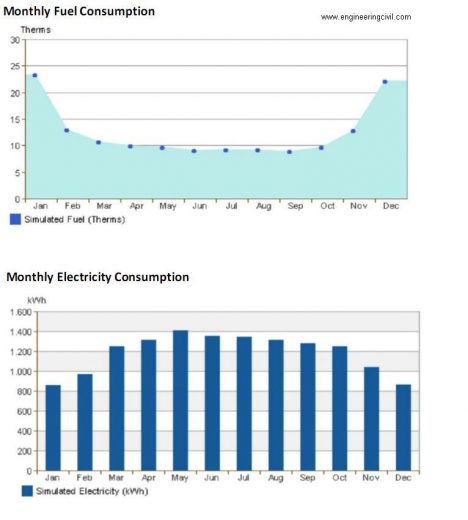
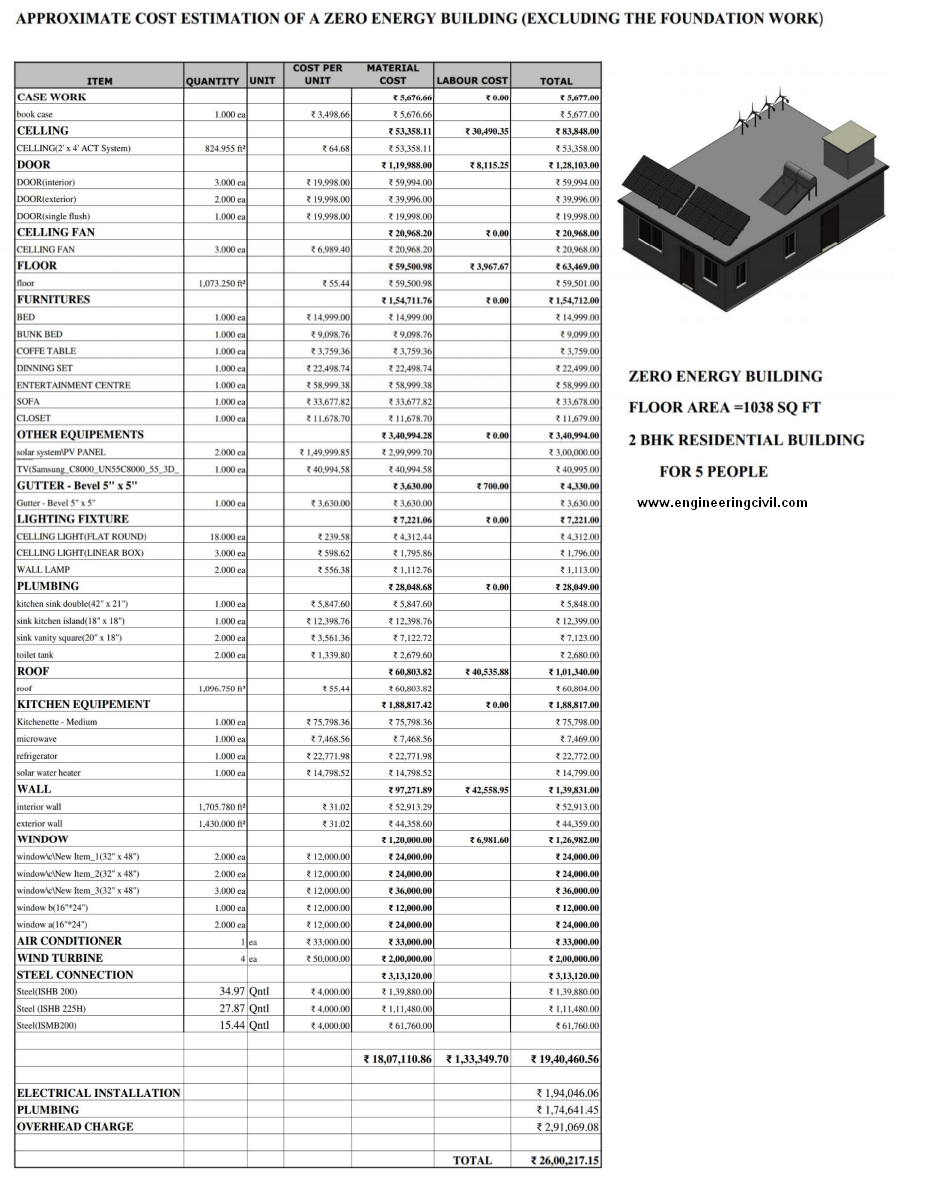
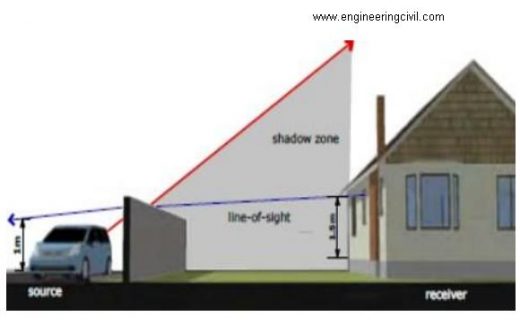
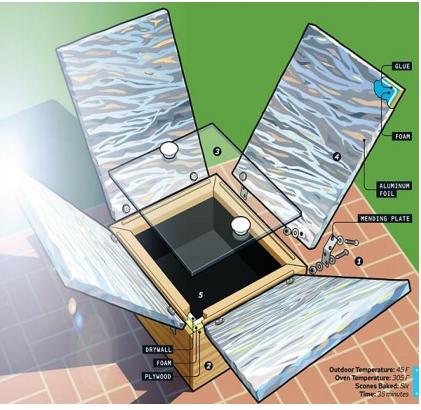
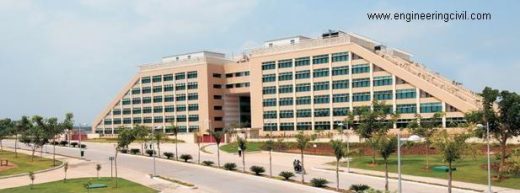
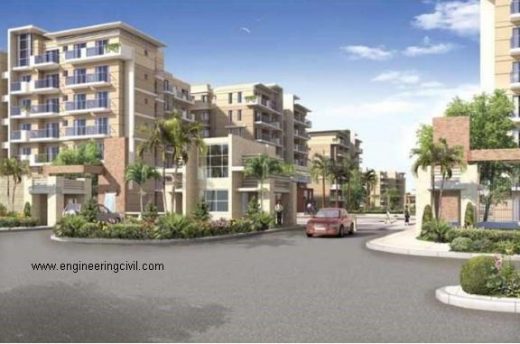
Give some extra introduction part
hey, I’m Venkat
I’m using your concept as my final year project. I’m interested in more concepts like this. If you can provide any details to contact any of you that would be great.
thankyou